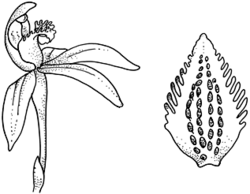Caladenia dimorpha Fitzg. APNI* Synonyms: Stegostyla dimorpha (Fitzg.) D.L.Jones & M.A.Clem. APNI*

Description: Terrestrial herb.
Leaf narrow-linear, to 18 cm long and 5 mm wide, sparsely hairy.
Inflorescence to 30 cm high, rarely > 3-flowered, sparsely hairy. Lateral sepals and lateral petals to 2 cm long, dorsal sepal to 1.5 cm long, the outer surfaces with scattered glandular hairs, and greenish, the inner surfaces glabrous, white (sometimes marked with pink-purplish markings); dorsal sepal cucullate, hooding the column. Labellum broad-ovate, c. 8 mm long, obscurely 3-lobed, white towards the base, sometimes with a dark red to purplish spot on the tip, upper half of the margins bearing slender, finger-like teeth with smooth to papillose stalks and narrowing, granular heads continuing to midlobe tip. Central calli in 4 rows, bearing clubbed, granular heads, white to yellow; heads become shorter towards tip until sessile, irregularly clumped and purple. Column with a papillose anther, broad apical wings, and red stripes; basal glands absent.
Flowering: September–October
Distribution and occurrence: Grows in sclerophyll forest in well-drained sand or loam; not common, south from Blue Mtns.
NSW subdivisions: CT, ST, CWS, SWS
Other Australian states: Vic.
Text by P. Bernhardt
Taxon concept: Flora of NSW 4 (1993)
APNI* Provides a link to the Australian Plant Name Index (hosted by the Australian National Botanic Gardens) for comprehensive bibliographic data
***The AVH map option provides a detailed interactive Australia wide distribution map drawn from collections held by all major Australian herbaria participating in the Australian Virtual Herbarium project.
|


